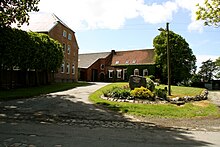Dykhusen Monastery
The Dykhusen monastery is a former monastery of the Augustinian order in East Frisia , which was taken over by the Dominicans around 1451 . It was located in Visquard , a district of today's Krummhörn municipality .
history
The dollar slump , which endangered the Osterreide monastery, was possibly decisive for the establishment of Dykhusen. The monastery was founded in 1376 by the chiefs Ocko I. tom Brok , Folkmar Allena zu Osterhusen and Haro Ailts zu Großfaldern and founded by Dodo, pastor in the north and Bremen official in East Friesland. The chiefs bought the land required for this from the chaplain Lüppoldus von Dykhusen, who they paid for with lifelong guaranteed income. The chaplain also left the chapel of the place to the order, which was the starting point of the monastery. The chiefs Ocko I. tom Brok and Folkmar Allena placed this under their protection immediately after it was founded. Two years later it is reported in the Norder Annalen that nuns from Osterreide have moved into the new monastery. They then set up the convent with the consent of the bishop and the cathedral chapter of Münster and dedicated it to Saint Margaret .
The first prioress of the monastery was Heba von Hinte, sister-in-law Ocko tom Broks and sister of Foelke Kampana, who achieved fame under the name Quade Foelke . The donors continued to exert influence on the monastery even after it was founded. In 1380 the chaplain had to give an account of the monastery’s income to the chiefs. After both got into a feud, the chiefs Edo von Rüstringen, Lauwert von Norden and Popke von Östringen, allied with Folkmar Allena, invaded Ocko's sphere of influence and placed the monastery under their protection in 1382. In 1451 at the latest, the convent joined the Dominican order . Presumably this happened under the influence of the north monastery . In 1467 Dykhusen is said to have been damaged by troops from the city of Groningen. However, this did not mean any major cuts in everyday monastery life. A preserved brick from the year could indicate the reconstruction.
In 1531 the monastery was sacked by the troops of chief Balthasar von Esens . Count Enno II forbade the reconstruction of Dykhusen and then brought the nuns to the Carmelite monastery in Appingen near Greetsiel . From then on, the land was administered by a count's servant. The long lease remained with the nuns. After her death, Appingen probably took over the rights to the Dykhusen monastery, which it sold for demolition in 1541. From 1545, the count's administration leased the monastery land as a domain . Several farms were later built on the deserted monastery, the foundations of which are believed to be the remains of the monastery church. In one house there is also a vaulted cellar with stones in the form of a monastery.
literature
- Josef Dolle: Dykhusen - Augustinian women, then Dominican women . In: Josef Dolle with the collaboration of Dennis Kniehauer (Ed.): Lower Saxony Monastery Book. Directory of the monasteries, monasteries, comedians and beguinages in Lower Saxony and Bremen from the beginnings to 1810 . Part 1-4. Bielefeld 2012, ISBN 3895349569 . Pp. 346-349.
- Hemmo Suur: History of the former monasteries in the province of East Friesland: An attempt . Hahn, Emden 1838. P. 110 ff. (Reprint of the edition from 1838, Verlag Martin Sendet, Niederwalluf 1971, ISBN 3-500-23690-1 ).
Individual evidence
- ↑ a b c d e Josef Dolle: Dykhusen - Augustinian women, then Dominican women . In: Josef Dolle with the collaboration of Dennis Kniehauer (Ed.): Lower Saxony Monastery Book. Directory of the monasteries, monasteries, comedians and beguinages in Lower Saxony and Bremen from the beginnings to 1810 . Part 1-4. Bielefeld 2012, ISBN 3895349569 . Pp. 346-349.
- ↑ Hemmo Suur: History of the former monasteries in the province of East Friesland (Emden 1838), p. 110
Coordinates: 53 ° 27 ′ 44 " N , 7 ° 6 ′ 41.7" E
